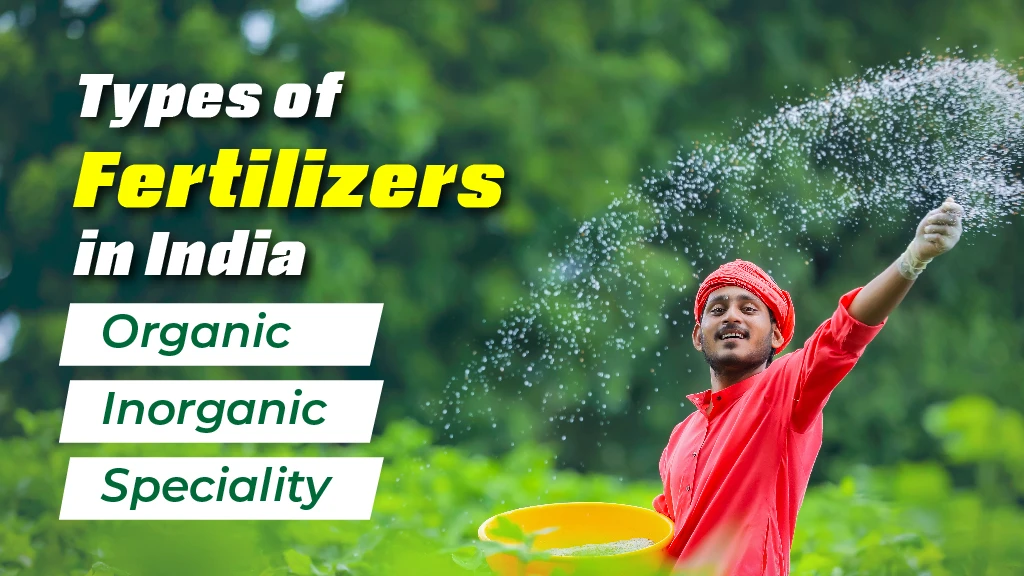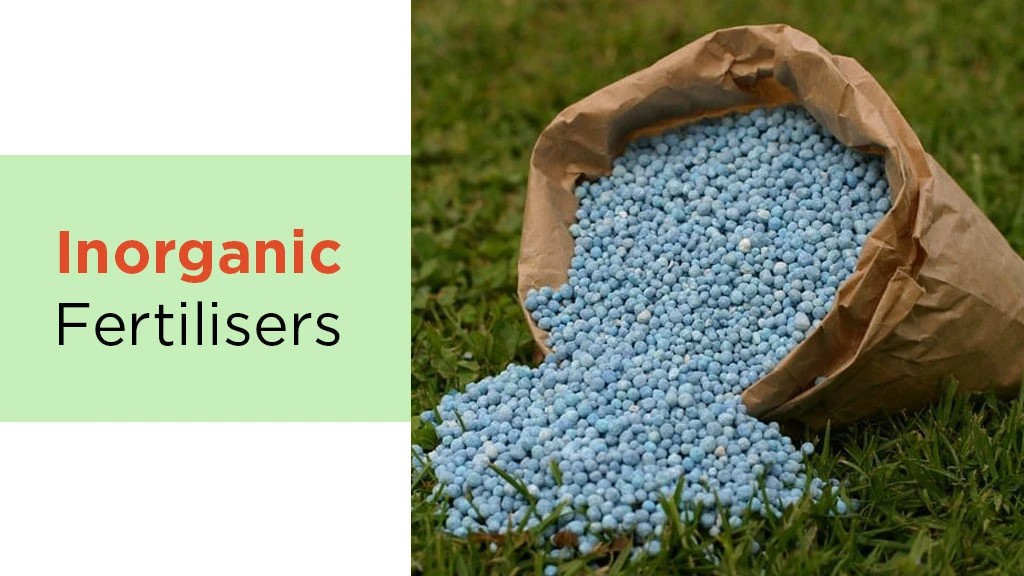Types of Fertilisers Used in Agriculture in India and their Importance

Table of Contents
- What is the Role of Fertilizers in Improving Crop Production?
- What are the Different Types of Fertilizers?
- Speciality Fertilizers
- What is the Status of the Fertilizer Market in India?
- What is the Future Prospects of Fertilizers?
What is the Role of Fertilizers in Improving Crop Production?
As the food demand is continuously increasing due to rapid population growth, it is difficult to fulfil this demand with decreasing resources. Fertilizer is a natural or synthetic substance added to the soil to promote crop growth. It increases soil fertility by providing essential nutrients for healthy crop growth. Sometimes, the soil does not have enough macro and micronutrients to grow good-quality crops. Fertilizers act as an alternative nutrition source, so plants get suitable nourishment and grow well. They also ensure a higher yield that allows farmers to earn more.
Also, agriculture faces a number of challenges, like pests, diseases, and soil fertility loss. This is why using fertilizers in agriculture is necessary to produce more crops while making them resilient towards the mentioned challenges. Some examples of fertilizers are manure, compost, NPK fertilizers and Liquid fertilizer.
What are the Different Types of Fertilizers?
A crop needs several nutrients from the soil to grow ideally. Fertilizer application is necessary to resolve the issue of nutrient deficiencies. There are different types of fertilizers based on the amount of nutrients they offer and their production method. The majority of fertilizers have three nutrients essential in their composition for healthy crop growth: Nitrogen (N), Phosphorus (P) and Potassium (K).
Indian farmers use various types of fertilizers to improve soil fertility. However, the most widely used fertilizer is Urea, which is a chemical fertilizer. Organic fertilizers also have been in use for a long time now. In 2016, Sikkim became the first state to adopt organic practices for all its agricultural land. New types of fertilizers have also been developed to prevent pest outbreaks and nutrient deficiency.
All the different types of fertilizers are discussed in detail in the following sections:
Organic Fertilizers

Living organisms like plants and animals produce organic fertilizers. Mirco-organisms in the soil decompose their organic matter and provide nutrients to the soil. These fertilizers contain essential nutrients that promote soil fertility.
Organic fertilizers improve the texture of soil due to which its water-retention capacity increases. They are also rich in organic matter that allow micro-organisms to thrive. Also, the release of nutrients like nitrogen is slower, preventing the risk of root burning.
As they do not have harmful chemicals, they do not have a negative environmental impact. Thus, they promote ecological balance and sustainable agriculture in India. This is why organic fertilizers are an important component of organic farming.
Manure
The decay of plant and animal waste prepares manure. Examples of manure sources include cattle shed waste (urine and dung), slaughterhouse waste (meat meal and bone meal) and crop waste (stubbles and sugarcane trash).
Manure is a rich source of macronutrients and increases soil fertility. This fertilizer is cost-effective as farmers can easily produce it using natural and local sources like cow dung, goat droppings, crop waste, and organic waste from households.
Compost
Compost is prepared by decomposing a variety of organic materials, like farm waste, food waste, and crop residues. Generally, it uses food and plant waste, but it can also contain livestock waste. Composting involves the rotting of organic materials in a compost pit, which is usually kept covered.
Micro-organisms in the soil use oxygen to break down the organic matter and form a nutrient-rich product called compost. This compost provides key nutrients to the soil and improves its fertility. It also promotes the growth of valuable micro-organisms in the soil. This compost is widely used in urban agriculture, gardens and horticulture in India.
Vermicompost
Earthworms prepare vermicompost by consuming organic matter like plant residues and biological waste material. Their excretion is called earthworm casts and is rich in nutrients and humus. Examples of biodegradable wastes for preparing vermicompost are vegetable waste, hotel refuse, weed biomass, crop residues and agroindustry waste.
Nutrient-rich castings make the soil rich in micro-organisms and nutrients as they contain higher amounts of nitrogen, phosphorus and potassium. Vermicompost improves the aeration, structure and water-holding capacity of the soil. It uses organic waste efficiently to reduce soil-borne diseases and weed growth.
Inorganic Fertilizers

Inorganic fertilizers are prepared using chemical processes to provide specific nutrients in desired quantities. The main benefit of these fertilizers is that they are more soluble than organic fertilizers and thus release nutrients quickly in the soil. Inorganic fertilizers provide macronutrients in large amounts, mainly NPK, along with secondary and micronutrients. The key types of inorganic fertilizers are:
Nitrogen Fertilizers
Nitrogen fertilizers are used to provide nitrogen to the plant. Nitrogen deficiency is a common issue in soil. Thus, most fertilizers in India are nitrogen fertilizers. There are several ways in which these fertilizers impact crop growth. Nitrogen fertilizer promotes the growth of foliage and makes the plant more tender and succulent. Common examples of nitrogen fertilizers are calcium ammonium nitrate, ammonium sulphate and Urea.
Phosphorus Fertilizers
As the name suggests, this type of fertilizer is rich in phosphorus. It is prepared with the help of rock phosphate. Plants have phosphorus in the cell protoplasm, which is vital for cell growth. The roots of plants, fruits and flowers grow well because of phosphorus fertilizer.
Phosphorus fertilizers improve nutrient uptake and ensure quality produce and higher yields. Some of the main phosphorus fertilizers that are available commercially include dicalcium phosphate, triple super phosphate and single superphosphate.
Potassium Fertilizers
Potassium is among the essential macronutrients that ensure ideal plant growth. There is an improvement in crop productivity through good potassium nutrition. Potassium deficiency can hamper crop growth and result in lower yields.
Also, potassium improves access to water from deeper soil layers by increasing the length and density of roots. This makes crops drought tolerant. Some of the common potassium fertilizers are potassium sulphate and potash.
Mixed Fertilizers
A mixed fertilizer has more than a single macronutrient for crops. It is prepared by mixing the ingredients carefully through a manual or mechanical process. This fertilizer promotes plant growth by making major macronutrients (NPK) available to crops through the same material.
Another benefit is that the proportion of nutrients can be changed based on the soil and crop profile. It helps to achieve balanced manuring and increase yield and profit for farmers. Examples of popular mixed fertilizers are calcium ammonium nitrate, ammonium phosphate sulphate, nitro-phosphate and di-ammonium phosphate or DAP fertilizers.
Speciality Fertilizers
Speciality fertilizers are used to provide targeted formulations and nutrients to fulfil the particular demands of crops. Due to this targeted approach, they can significantly improve crop yields. Speciality fertilizers can impact specific metabolic functions and growth stages in plants. There is an improvement in nutrient delivery because of the specialized aspect of these fertilizers.
The use of speciality fertilizers is increasing due to the demand for higher production and adoption of precision agriculture practices. The key benefits of these fertilizers include fulfilling the specific nutrient demands of crops, slowing bacterial activity and improving nutrient availability. Following are the different types of speciality fertilizers:
Water Soluble Fertilizers
With the help of an irrigation system, water soluble fertilizers or WSFs are applied to crops directly. The key feature of WSFs is that they are absorbed by plants easily and efficiently. These fertilizers are used in various settings, including precision farming, greenhouses and hydroponics. Also, nutrient uptake becomes more efficient and improves crop quality and yield.
Neem Coated Fertilizers
This fertilizer uses a coating of neem on Urea so that the release of nitrogen can be slowed down. Thus, there is less loss of nitrogen due to leaching. In addition, it protects the crops against insects and pests. Nitrogen is provided to plants efficiently. It results in healthy and higher crop yields.
Liquid Fertilizers
Liquid fertilizers are directly applied using foliar spray or with the help of irrigation water. Farmers prefer this fertilizer as it offers convenient application and the opportunity to mix it with herbicides. It allows the roots and leaves of plants to absorb nutrients quickly. If there is a nutrient imbalance, liquid fertilizers can promptly fix it.
The following table shows the fertilizers used by farmers in India:
|
Organic Fertilizers |
Manure |
|
Compost |
|
|
Vermicompost |
|
|
Inorganic Fertilizers |
Nitrogen Fertilizers |
|
Phosphorus Fertilizers |
|
|
Potassium Fertilizers |
|
|
Mixed Fertilizers |
|
|
Speciality Fertilizers |
Water Soluble Fertilizers |
|
Neem Coated Fertilizers |
|
|
Liquid Fertilizers |
What is the Status of the Fertilizer Market in India?
According to the Economic Diplomacy Division of Ministry of External Affairs, in 2024, the market size of the fertilizer industry of India was INR 942.1 billion. It is expected to grow at a compounded annual growth rate of 4.2% during 2024-2032 to reach INR 1380 billion by 2032. The total fertilizer production in 2024 stood at 45.2 million tonnes driven by increase in agricultural demand and strategic intervention from the government.
The Government of India aims to become self-sufficient in fertilizers by 2032. Due to initiatives like Atmanirbhar Bharat, the imports of urea decline by 7%, NPKs by 21% and DAP by 22% in the financial year 2024. Further, the government will increase the number of nano liquid urea plants from 9 to 13 by 2025.
What is the Future Prospects of Fertilizers?
The use of synthetic fertilizers has severe environmental impacts like groundwater contamination, greenhouse gas emissions, eutrophication and soil degradation. But there is no possibility of completely ending the use of fertilizers. More inputs are needed to obtain higher yields. Rapid degradation of resources like land, water and soil makes growing high-quality produce even more challenging.
So, farmers can gradually reduce the use of fertilizers while ensuring their productivity does not reduce. Organic farming is a highly sustainable farming method that only uses organic manure to improve soil fertility. Other helpful practices to make the soil more fertile include growing cover crops, crop rotation, intercropping and mulching.
The government of India also supports the use of organic fertilizers through different schemes and subsidies. It is obvious that more food production is needed, and agriculture fertilizers play a big role in it. However, care needs to be taken so that there is no indiscriminate use of chemical fertilizers.
Frequently Asked Questions On Types of Fertilisers Used in Agriculture in India and their Importance
1. What are the fertilizers?
Fertilizers are natural or synthetic substances that are added to the soil to increase soil fertility and promote healthy crop growth.
2. What are the top three fertilizers?
The top three fertilizers are Nitrogen, Phosphorus and Potassium fertilizer.
3. What are the three uses of fertilizers?
The uses of fertilizers include increased soil fertility, meeting the nutritional needs of crops and increased crop output.
4. Why are manure and fertilizers used in fields?
Manure and fertilizers are used in fields to ensure soil receives essential nutrients for healthy crop growth.
5. What is DAP fertilizer?
DAP, or di-ammonium phosphate, is a mixed fertilizer that is widely used in India.


Related Blogs















